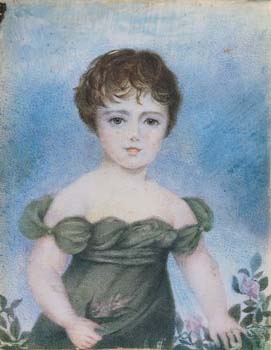Miniature Portrait of Young Girl
- Early 19th century
- Artist unknown
- Watercolor on ivory
8.0 x 6.5 cm., 3-1/8 x 2-1/2"
- Catherine Carter Goebel, Paul A. Anderson Chair in the Arts Purchase, Paul A. Anderson Art History Collection, Augustana College 2000.4

Essay by Michael Nolan, Former Adjunct Instructor of English
The nineteenth-century American Miniature Portrait of a Young Girl is heir to a long tradition. Miniatures grew from earlier forms of art, such as illuminated medieval religious manuscripts. Illuminated manuscripts often included a small painting showing the person who had financed the manuscript's reproduction, in prayer or handing the sacred text to a saint.
A second type of early influence—ancient portrait medallions, coins, and cameos—suggests a more public emphasis. Painted on vellum, early miniatures portrayed the kings, queens, and nobles in European courts. Miniatures came to the American colonies from Britain in the 1700s. At first those with political prominence were painted, such as the Revolutionary War heroes and early presidents. Upper and middle-class Americans became enamored with miniatures, commissioning them for life's signal moments, including births, engagements, marriages, and deaths.
The Miniature Portrait of a Young Girl was painted by an unknown American artist, most likely self taught, given the uneven technique. There is evidence of painterly skill: the girl's tousled hair is handled with finesse, set down in fine lines creating feathered locks that fall with a naturalness over the forehead. Refined brushwork creates the delicately blended hues of the girl's face. But there is awkwardness in the girl's hands, and neither the flowers nor clothing are represented with equivalent vividness. Does the miniature memorialize a dead child? Nineteenth-century iconography of death typically shows flowers with closed blooms. In the nineteenth-century "language of flowers," sweet peas were associated with "departure." But other pea blossoms were associated with the "everlasting, an appointed meeting, and lasting pleasure." If the flowers have a language, they offer us contradictory advice.
Whatever its intent, the portrait conveys strong affection for the child. The miniature's size and rectangular shape suggest that it was not carried or worn, but displayed. Perhaps the portrait was more akin to a studio photograph, meant, of course, to be a likeness, but also to capture something particular about the child. Today nearly 180 years later, it is hard not to be intrigued by the image, to wonder who the child was and who loved her enough to have her painted.
